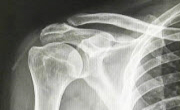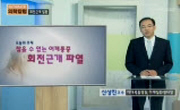Purpose: Rotator cuff disease (RCD) is a common cause of shoulder pain. However little is known about the progression of RCD during conservative management. This study aimed to identify the progression of RCD using magnetic resonance imaging (MRI). M...
http://chineseinput.net/에서 pinyin(병음)방식으로 중국어를 변환할 수 있습니다.
변환된 중국어를 복사하여 사용하시면 됩니다.
- 中文 을 입력하시려면 zhongwen을 입력하시고 space를누르시면됩니다.
- 北京 을 입력하시려면 beijing을 입력하시고 space를 누르시면 됩니다.

자기공명영상을 이용한 회전근 개 질환의 경과 관찰 = A Follow-Up Study of Rotator Cuff Tear Using Magnetic Resonance Imaging
한글로보기https://www.riss.kr/link?id=A105122418
- 저자
- 발행기관
- 학술지명
- 권호사항
-
발행연도
2018
-
작성언어
Korean
- 주제어
-
등재정보
KCI등재
-
자료형태
학술저널
- 발행기관 URL
-
수록면
38-43(6쪽)
-
KCI 피인용횟수
1
- DOI식별코드
- 제공처
- 소장기관
-
0
상세조회 -
0
다운로드
부가정보
다국어 초록 (Multilingual Abstract)
Purpose: Rotator cuff disease (RCD) is a common cause of shoulder pain. However little is known about the progression of RCD during conservative management. This study aimed to identify the progression of RCD using magnetic resonance imaging (MRI).
Materials and Methods: This study was conducted between 2013 and 2015; 48 patients who underwent MRI after at least one year of conservative treatment for RCD were enrolled for follow-up analysis. Rotator cuff tear (RCT) and retraction were measured using an MRI.
Tear progression was defined as an increase of 3 mm or more in tear size or retraction. Patients were divided into two groups: Small tear group and medium/large tear group. The progression of tears was analyzed.
Results: RCT occurred in 25 cases and tendinosis occurred in 23 cases. The progression was observed in 12 cases (48.0%), and new tears were observed in 2 cases (8.7%). The pre-treatment tear size and retraction were 17.8 mm and 18.9 mm, respectively; while the post treatment tear size and amount of tendon retraction were 20.2 mm and 22.3 mm, respectively. The pre-treatment anteroposterior diameter of tears showed a positive correlation with the pre-treatment tendon retraction (r=0.830, p<0.001) but a negative correlation with the anteroposterior tear size progression (r=-0.473, p=0.017). Small size tears were found in 5 cases (20.0%) and medium/large size tears were found in 20 cases (80.0%). Among the 5 cases of small size tears, 4 cases (80.0%) showed progression, with a mean anteroposterior diameter of 7.4 mm and a mean amount of retraction of 5.9 mm. Among the 20 cases with medium/large size tears, 8 cases (40.0%) showed progression, with a mean anteroposterior diameter of 4.1 mm and a mean retraction of 6.8 mm. The frequency of tear progression was significantly different between the two groups (p<0.001).
Conclusion: The need to use MRI monitoring during the conservative treatment of rotator cuff tears to evaluate the possibility of switching to surgical treatment. This study also suggests that an aggressive surgical treatment should be considered even for small tears, since the size of tear and retraction of tears may progress similarly regardless of the size of tear.
국문 초록 (Abstract)
목적: 회전근 개 질환은 견관절 통증의 흔한 원인이다. 그러나 보존적 치료 시 파열의 진행이나 파열의 발생에 대해서는 잘 알려져있지 않아 자기공명영상을 이용하여 회전근 개 질환의 진...
목적: 회전근 개 질환은 견관절 통증의 흔한 원인이다. 그러나 보존적 치료 시 파열의 진행이나 파열의 발생에 대해서는 잘 알려져있지 않아 자기공명영상을 이용하여 회전근 개 질환의 진행 정도를 알아보고자 하였다.
대상 및 방법: 2013년부터 2015년까지 회전근 개 질환으로 최소 1년 이상 보존적 치료를 시행 후 자기공명영상을 촬영한 48예를 대상으로 하였다. 나이는 평균 64.3세(범위, 45-83세), 추시 기간은 평균 17.6개월(범위, 12-37개월)이었다. 자기공명영상에서 파열의전후 크기와 대결절부터 건의 퇴축을 측정하였다. 파열의 크기나 건의 퇴축이 3 mm 이상 증가 시 파열의 진행으로 정의하였다. 10 mm 미만의 소 파열과 10 mm의 중·대 파열 두 군으로 나누어 파열의 진행을 분석하였다.
결과: 치료 전 자기공명영상에서 회전근 개 파열은 25예였으며, 회전근 개 부분 파열은 23예였다. 파열의 진행은 12예(48.0%), 회전근 개 부분 파열에서 새로운 파열이 2예(8.7%) 관찰되었다. 파열 크기는 치료 전 전후 직경 17.8 mm, 건의 퇴축 18.9 mm였으며, 치료 후 각각 20.2 mm, 22.3 mm였다. 치료 전 파열의 전후 크기는 수술 전 퇴축과 양의 상관관계(r=0.830, p<0.001), 전후 크기의진행과 음의 상관관계(r=-0.473,p=0.017)를 보였다. 소 파열은 5예(20.0%)였고 중·대 파열은 20예(80.0%)였다. 소 파열군 5예중 4예(80.0%)에서 진행하였고 전후 크기는 평균 7.4 mm (범위, 4.1-11.7 mm), 퇴축은 5.9 mm (범위, 4.7-7.7 mm) 진행하였다.
중·대 파열군 20예 중 8예(40.0%)에서 파열이 진행하였으며 전후 크기는 평균 4.1 mm (범위, 0.16-.3 mm), 퇴축은 6.8 mm (범위 , 3.4-14.8 mm) 진행하였다. 소 파열군과 중·대 파열군에서 파열 진행의 빈도는 통계적으로 유의한 차이를 였보다(p<0.001).
결론: 회전근 개 파열의 보존적 치료 시 자기공명영상을 통한 추시 관찰을 통해 수술적 치료로의 전환을 고려해야 할 것으로 생각되며 소 파열군에서도 중·대 파열과 같이 파열의 크기와 퇴축이 진행하므로 소 파열의 경우에도 적극적인 수술적 치료를 고려해야 한다.
참고문헌 (Reference)
1 Kukkonen J, "Treatment of non-traumatic rotator cuff tears: a randomised controlled trial with one-year clinical results" 96 : 75-81, 2014
2 Eljabu W, "The natural history of rotator cuff tears: a systematic review" 135 : 1055-1061, 2015
3 Moosmayer S, "The natural history of asymptomatic rotator cuff tears: a three-year follow-up of fifty cases" 95 : 1249-1255, 2013
4 Moosmayer S, "Tendon repair compared with physiotherapy in the treatment of rotator cuff tears: a randomized controlled study in 103 cases with a fiveyear follow-up" 96 : 1504-1514, 2014
5 Dunn WR, "Symptoms of pain do not correlate with rotator cuff tear severity: a cross-sectional study of 393 patients with a symptomatic atraumatic full-thickness rotator cuff tear" 96 : 793-800, 2014
6 Itoi E, "Surgical repair did not improve functional outcomes more than conservative treatment for degenerative rotator cuff tears" 98 : 314-, 2016
7 McElvany MD, "Rotator cuff repair: published evidence on factors associated with repair integrity and clinical outcome" 43 : 491-500, 2015
8 Tashjian RZ, "Risk of tear progression in nonoperatively treated small full-thickness rotator cuff tears: commentary on an article by Sandro F. Fucentese, MD, et al.: "evolution of nonoperatively treated symptomatic isolated full-thickness supraspinatus tears"" 94 : e61-, 2012
9 Meyer DC, "Retraction of supraspinatus muscle and tendon as predictors of success of rotator cuff repair" 40 : 2242-2247, 2012
10 Park JS, "Prognostic factors affecting rotator cuff healing after arthroscopic repair in small to medium-sized tears" 43 : 2386-2392, 2015
1 Kukkonen J, "Treatment of non-traumatic rotator cuff tears: a randomised controlled trial with one-year clinical results" 96 : 75-81, 2014
2 Eljabu W, "The natural history of rotator cuff tears: a systematic review" 135 : 1055-1061, 2015
3 Moosmayer S, "The natural history of asymptomatic rotator cuff tears: a three-year follow-up of fifty cases" 95 : 1249-1255, 2013
4 Moosmayer S, "Tendon repair compared with physiotherapy in the treatment of rotator cuff tears: a randomized controlled study in 103 cases with a fiveyear follow-up" 96 : 1504-1514, 2014
5 Dunn WR, "Symptoms of pain do not correlate with rotator cuff tear severity: a cross-sectional study of 393 patients with a symptomatic atraumatic full-thickness rotator cuff tear" 96 : 793-800, 2014
6 Itoi E, "Surgical repair did not improve functional outcomes more than conservative treatment for degenerative rotator cuff tears" 98 : 314-, 2016
7 McElvany MD, "Rotator cuff repair: published evidence on factors associated with repair integrity and clinical outcome" 43 : 491-500, 2015
8 Tashjian RZ, "Risk of tear progression in nonoperatively treated small full-thickness rotator cuff tears: commentary on an article by Sandro F. Fucentese, MD, et al.: "evolution of nonoperatively treated symptomatic isolated full-thickness supraspinatus tears"" 94 : e61-, 2012
9 Meyer DC, "Retraction of supraspinatus muscle and tendon as predictors of success of rotator cuff repair" 40 : 2242-2247, 2012
10 Park JS, "Prognostic factors affecting rotator cuff healing after arthroscopic repair in small to medium-sized tears" 43 : 2386-2392, 2015
11 Hsu J, "Natural history of rotator cuff disease and implications on management" 25 : 2-9, 2015
12 Yamaguchi K, "Natural history of asymptomatic rotator cuff tears: a longitudinal analysis of asymptomatic tears detected sonographically" 10 : 199-203, 2001
13 Gasbarro G, "Morphologic risk factors in predicting symptomatic structural failure of arthroscopic rotator cuff repairs: tear size, location, and atrophy matter" 32 : 1947-1952, 2016
14 Clement ND, "Management of degenerative rotator cuff tears: a review and treatment strategy" 4 : 48-, 2012
15 Schaefer O, "Magnetic resonance imaging for supraspinatus muscle atrophy after cuff repair" 403 : 93-99, 2002
16 Seok Won Chung, "Is the Supraspinatus Muscle Atrophy Truly Irreversible after Surgical Repair of Rotator Cuff Tears?" 대한정형외과학회 5 (5): 55-65, 2013
17 Abdul-Wahab TA, "Initial treatment of complete rotator cuff tear and transition to surgical treatment: systematic review of the evidence" 6 : 35-47, 2016
18 Goutallier D, "Influence of cuff muscle fatty degeneration on anatomic and functional outcomes after simple suture of full-thickness tears" 12 : 550-554, 2003
19 Goutallier D, "Impact of fatty degeneration of the suparspinatus and infraspinatus msucles on the prognosis of surgical repair of the rotator cuff" 85 : 668-676, 1999
20 Tae SK, "Evaluation of fatty degeneration of the supraspinatus muscle using a new measuring tool and its correlation between multidetector computed tomography and magnetic resonance imaging" 39 : 599-606, 2011
21 Tashjian RZ, "Epidemiology, natural history, and indications for treatment of rotator cuff tears" 31 : 589-604, 2012
22 Kuhn JE, "Effectiveness of physical therapy in treating atraumatic full-thickness rotator cuff tears: a multicenter prospective cohort study" 22 : 1371-1379, 2013
23 Moosmayer S, "Comparison between surgery and physiotherapy in the treatment of small and medium-sized tears of the rotator cuff: a randomised controlled study of 103 patients with one-year follow-up" 92 : 83-91, 2010
24 Lambers Heerspink FO, "Comparing surgical repair with conservative treatment for degenerative rotator cuff tears: a randomized controlled trial" 24 : 1274-1281, 2015
25 Zingg PO, "Clinical and structural outcomes of nonoperative management of massive rotator cuff tears" 89 : 1928-1934, 2007
26 Woo Hyung Lee, "Clinical Outcomes of Conservative Treatment and Arthroscopic Repair of Rotator Cuff Tears: A Retrospective Observational Study" 대한재활의학회 40 (40): 252-262, 2016
27 Chung SW, "Arthroscopic repair of partial-thickness and small full-thickness rotator cuff tears: tendon quality as a prognostic factor for repair integrity" 43 : 588-596, 2015
28 Tempelhof S, "Age-related prevalence of rotator cuff tears in asymptomatic shoulders" 8 : 296-299, 1999
29 Keener JD, "A prospective evaluation of survivorship of asymptomatic degenerative rotator cuff tears" 97 : 89-98, 2015
동일학술지(권/호) 다른 논문
-
슬관절 화농성 관절염의관절경적 활액막 절제술 후 발생한 가성동맥류
- 대한정형외과학회
- 이성준
- 2018
- KCI등재
-
- 대한정형외과학회
- 심대무
- 2018
- KCI등재
-
- 대한정형외과학회
- 김정재
- 2018
- KCI등재
-
- 대한정형외과학회
- 박기철
- 2018
- KCI등재
분석정보
인용정보 인용지수 설명보기
학술지 이력
| 연월일 | 이력구분 | 이력상세 | 등재구분 |
|---|---|---|---|
| 2026 | 평가예정 | 재인증평가 신청대상 (재인증) | |
| 2020-04-14 | 학회명변경 | 영문명 : 미등록 -> The Korean Orthopaedic Association |  |
| 2020-01-01 | 평가 | 등재학술지 유지 (재인증) |  |
| 2017-01-01 | 평가 | 등재학술지 유지 (계속평가) |  |
| 2014-01-14 | 학술지명변경 | 외국어명 : 미등록 -> Journal of the Korean Orthopaedic Association |  |
| 2013-01-01 | 평가 | 등재학술지 유지 (등재유지) |  |
| 2010-01-01 | 평가 | 등재 1차 FAIL (등재유지) |  |
| 2008-01-01 | 평가 | 등재학술지 유지 (등재유지) |  |
| 2005-05-30 | 학술지등록 | 한글명 : 대한정형외과학회지외국어명 : 미등록 |  |
| 2005-01-01 | 평가 | 등재학술지 선정 (등재후보2차) |  |
| 2004-01-01 | 평가 | 등재후보 1차 PASS (등재후보1차) |  |
| 2002-07-01 | 평가 | 등재후보학술지 선정 (신규평가) |  |
학술지 인용정보
| 기준연도 | WOS-KCI 통합IF(2년) | KCIF(2년) | KCIF(3년) |
|---|---|---|---|
| 2016 | 0.06 | 0.06 | 0.08 |
| KCIF(4년) | KCIF(5년) | 중심성지수(3년) | 즉시성지수 |
| 0.08 | 0.08 | 0.24 | 0.01 |





 DBpia
DBpia







